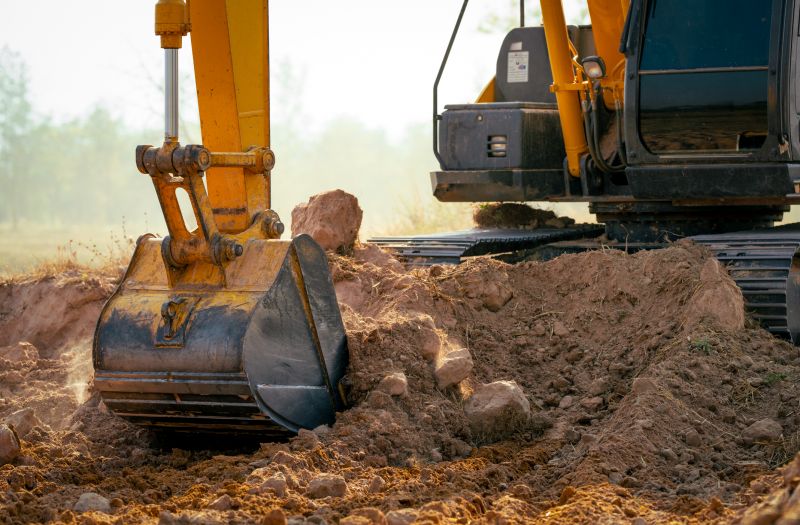Favorite Land Excavation Machinery for Skilled Contractors
Explore trusted equipment options that support effective land clearing, digging, and grading tasks.
 Land excavation services require a range of specialized equipment and tools to effectively prepare sites for construction, landscaping, or agricultural purposes. The selection of appropriate products depends on the scope of the project, terrain, and specific excavation needs. Heavy machinery such as excavators, backhoes, and bulldozers are commonly used for large-scale tasks, offering power and efficiency for moving substantial amounts of soil and debris. For smaller or more precise work, hand tools and compact equipment provide flexibility and control, allowing operators to navigate tighter spaces and perform detailed tasks.
Land excavation services require a range of specialized equipment and tools to effectively prepare sites for construction, landscaping, or agricultural purposes. The selection of appropriate products depends on the scope of the project, terrain, and specific excavation needs. Heavy machinery such as excavators, backhoes, and bulldozers are commonly used for large-scale tasks, offering power and efficiency for moving substantial amounts of soil and debris. For smaller or more precise work, hand tools and compact equipment provide flexibility and control, allowing operators to navigate tighter spaces and perform detailed tasks.
Top Overall Option
Multipurpose Excavation Attachment
A versatile excavation attachment designed to fit various skid steers and compact excavators, offering multiple functions such as digging, trenching, and material handling. Its adaptable design makes it suitable for a range of land excavation tasks, providing users with a flexible tool that can be easily swapped out for different jobs. This attachment is built with durable materials to withstand tough conditions and features easy installation for efficient operation.
Types of Products For Land Excavation Service
Excavator Buckets
Various bucket types including trenching, grading, and rock buckets to suit different excavation needs.
Backhoe Attachments
Attachments for backhoes such as augers, breakers, and grapples to expand functionality.
Skid Steer Loaders
Compact loaders equipped with various attachments for small to medium excavation tasks.
Mini Excavators
Small-scale excavators ideal for tight spaces and detailed excavation work.
Hydraulic Breakers
Heavy-duty tools used for breaking through concrete, rock, and other tough materials.
Augers
Drilling attachments for creating holes for posts, planting, or foundations.
Trenching Machines
Specialized equipment for digging narrow trenches for utilities and drainage.
Compactors
Equipment for soil compaction to stabilize and prepare land for construction.
Rippers
Attachments used to break up hard soil or rock layers before excavation.
Land Graders
Tools for leveling and smoothing land surfaces after excavation.
Dumpers
Small vehicles for transporting excavated material across the site.
Trenchers
Machines designed specifically for digging trenches efficiently and accurately.
Soil Mixers
Equipment for blending soil and amendments during site preparation.
Land Levelers
Tools for achieving a flat and even land surface post-excavation.
Crawler Dozers
Heavy tracked machines used for pushing large quantities of soil and grading.
Popular Choices
Compact and versatile, mini excavators are frequently used for small-scale and detailed excavation projects.
A range of attachments for skid steer loaders makes them adaptable for various excavation tasks.
Popular for breaking through concrete and rock, hydraulic breakers are essential for demolition tasks.
Efficient trenching equipment often chosen for utility and drainage installations.
Different bucket styles are commonly used to match specific digging and loading requirements.
Augers are trending for their ease in creating post holes and foundation openings.
Compact soil efficiently for stable land before construction or planting.
Popular for leveling and smoothing large land areas after excavation.
Transporting excavated material remains a common task, making dumpers a frequently used product.
Heavy-duty pushing and grading tasks often rely on crawler dozers for efficiency.
Used for breaking up tough soil and rock, rippers are gaining popularity for difficult terrain.
Trenchers are frequently selected for utility line installations and drainage work.
Understanding the different types of excavation equipment and accessories is essential for achieving optimal results. Attachments like buckets, breakers, and augers can enhance the versatility of standard machinery, enabling it to handle various tasks such as trenching, digging, or breaking through tough materials. Safety gear and maintenance supplies are also critical to ensure smooth operation and worker protection during excavation projects.
When selecting products for land excavation, considerations such as durability, compatibility with existing machinery, ease of use, and safety features should be prioritized. Proper training and adherence to safety protocols are vital for minimizing risks and ensuring efficient project completion. Whether you're managing a large construction site or undertaking a small landscaping project, having the right equipment can significantly impact the effectiveness and safety of your excavation efforts.
Key Buying Considerations
- Project scale and scope to determine the appropriate equipment size and capacity.
- Compatibility of attachments with existing machinery or tools.
- Durability and build quality to withstand tough excavation conditions.
- Ease of operation and control features for safety and efficiency.
- Safety features such as protective guards, emergency shut-offs, and stable design.
- Maintenance requirements and availability of replacement parts.
- Power source compatibility, including hydraulic, electric, or gas-powered options.
- Mobility and maneuverability in confined or challenging terrains.
- Cost considerations including purchase price, rental options, and long-term maintenance.
- Operator training and ease of use to ensure safe handling.
- Versatility of equipment to handle multiple tasks with interchangeable attachments.
- Environmental factors such as soil type and terrain that influence equipment choice.
- Storage space for equipment and accessories when not in use.
- Warranty and customer support offered by the manufacturer or supplier.
- Compliance with safety and industry standards relevant to your region.
